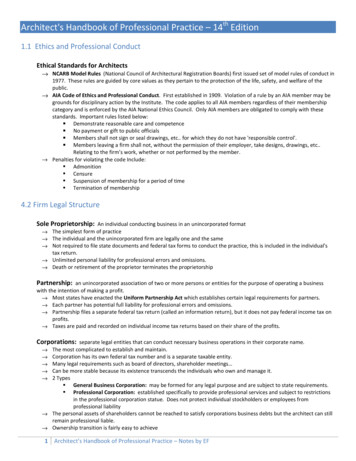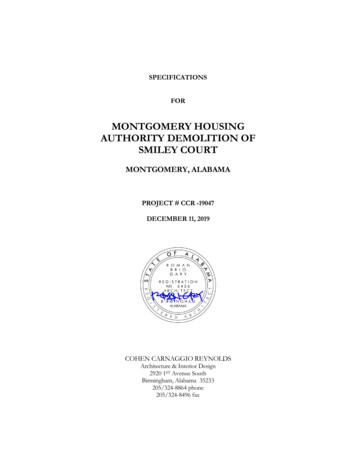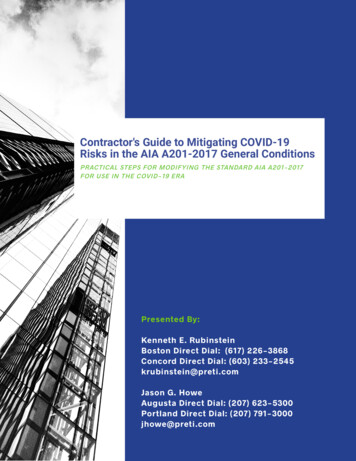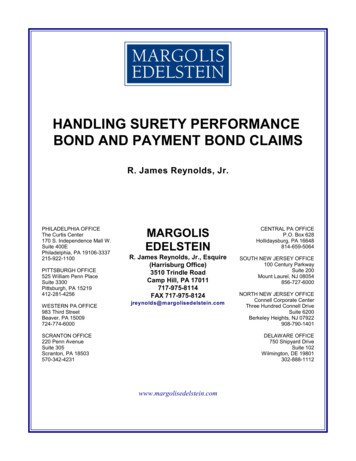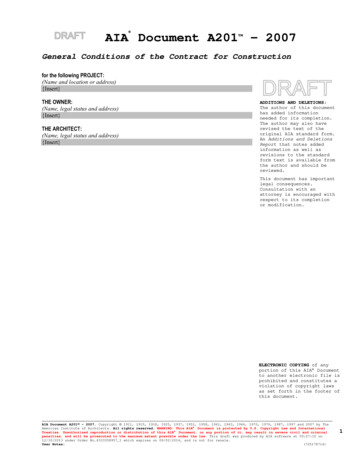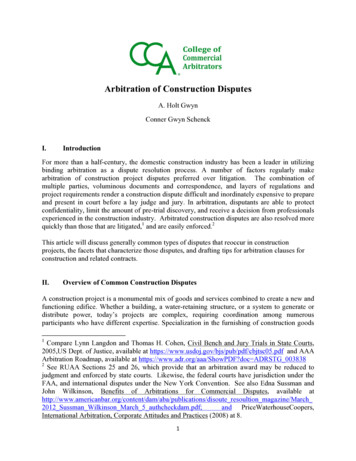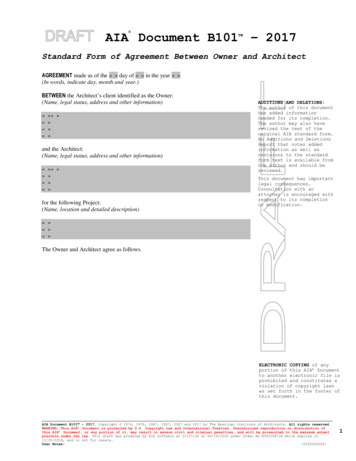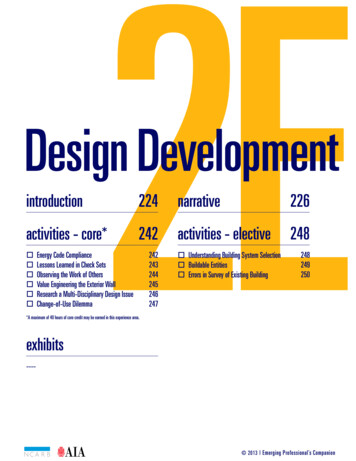
Transcription
2EDesign Developmentintroductionactivities - core* 224narrative226242activities - elective248Energy Code ComplianceLessons Learned in Check SetsObserving the Work of OthersValue Engineering the Exterior WallResearch a Multi-Disciplinary Design IssueChange-of-Use Dilemma242243244245246247 Understanding Building System Selection Buildable Entities Errors in Survey of Existing Building248249250*A maximum of 40 hours of core credit may be earned in this experience area.exhibits---- 2013 Emerging Professional’s Companion
Design DevelopmentIntroductionBy completing the activities in this chapter, you will gain an understandingof the activities involved in design development. The following informationis taken from the NCARB IDP Guidelines:Design DevelopmentMinimum Design Development Experience: 320 HoursDefinition: During design development, a project’s schematic design isrefined, including designing details and selecting materials. This stepoccurs after the owner/client has approved the schematic design.TasksAt the completion of your internship, you should be able to: Prepare design development documents Investigate and select building systems and materials Meet with client to refine design and obtain approvals Conduct or respond to a constructability review Apply sustainable design principles2E224Knowledge Of/Skill In 3-D modeling Adaptive reuse of buildings and/or materials Alternative energy systems and technologies Applied mathematics (e.g., algebra, geometry, trigonometry) Basic engineering principles Building design Building envelope Building Information Modeling (BIM) technology Building systems and their integration Characteristics and properties of construction materials Computer Aided Design and Drafting (CADD) Conflict resolution Constructability Construction details Construction sequencing Creativity and vision Critical thinking (e.g., analysis, synthesis, and evaluation ofinformation) Design impact on human behavior Design principles Designing and delivering presentations Engineering load calculations Freehand drawing and design sketching Furnishings, fixtures, and equipment Graphic communication Hazardous materials mitigation Implications of design decisions (e.g., cost, engineering, schedule) Indoor air quality Interior materials and finishesEmerging Professional’s Companion www.epcompanion.orgresourcesDownload the current InternDevelopment Program (IDP)guidelines at he American Institute ofArchitects. Demkin, Joseph A.,ed. The Architect’s Handbook ofProfessional Practice. 14th ed.Hoboken: John Wiley & Sons,2008. Chapter 12.2 - DesignPhasesThe American Institute ofArchitects. Demkin, Joseph A.,ed. The Architect’s Handbook ofProfessional Practice. 13th ed.New York: John Wiley & Sons,2001.The American Institute ofArchitects, The ArchitectureStudent’s Handbook ofProfessional Practice. 14th ed.Hoboken: John Wiley & Sons,2009. Chapter 7.3 - DesignPhases
Design DevelopmentKnowledge Of/Skill In Continued Interpersonal skills (e.g., listening, diplomacy, responsiveness) Life safety Managing quality through best practices Manual drafting Natural and electric lighting (e.g., daylight, solar control, energy consumption) Oral and written communications Problem solving Product evaluation, selection, and availability Project scheduling (e.g., construction document setup, storyboarding, staffing projections) Site design Space planning Spatial visualization and modeling Specifications Sustainable design Team building, leadership, participation Technological advances and innovative building products Universal design (environments usable by everyone regardless of limitations) Vertical circulation2EnotesTake brief notes while reading the narrative and list key resources you used to complete the activities. Notediscussion outcomes from meetings with your supervisor, mentor, or consultants. When finalizing the activitydocumentation (PDF), include your notes and the Emerging Professional’s Companion activity description.www.epcompanion.org Emerging Professional’s Companion225
Design DevelopmentNarrativeThe beginning of design development (DD) is a logical extension ofschematic design. DD tasks build on the approved schematic designto reach a level of completeness that demonstrates the project can bebuilt. The schematic design is overlaid with more detailed informationobtained from an array of multidisciplinary consultants and team members.Throughout DD, it is important to evaluate how systems, material selection,and detailing reflect the schematic design concept. The design team worksout detailed coordination issues, while enhancing the project, so that majorrevisions are not needed during construction documentation or, worse,during construction.Depiction of all aspects of the design, including architectural, structural,HVAC, electrical, plumbing, and fire protection systems are essential.Depending on the building type, acoustic and vibration considerations,lighting concepts, landscaping design, and other specialized factors alsoneed to be integrated into the design. Design development may relyon extensive three-dimensional representations (models, perspectives,animations, full-size mockups, etc.) to communicate both the overall designand details to the design team, the client, and the construction team.2EHistorically, schematic design, design development, and constructiondocumentation were distinct phases of project delivery. In a continuousprocess of evolution, refinement, and integration, digital developmentshave blurred these phases. Add to this the emergence of project deliverymethods beyond traditional design-bid build to methods emphasizingmultiple packages and sequential issuance of design information, and thecrisp lines between traditional project delivery phases are often gone.Design development documents are often similar to those in schematicdesign, but contain more detail in the drawings and specifications andmay—depending on the contract—be accompanied by an updated costestimate. The client reviews these documents and, upon the client’s writtenapproval, construction documentation begins. In some project deliverymethods, the issuance of production information and even commencementof construction overlap the design development phase. In these instances,the architect must focus sooner on systems that affect early stages in thework.Architects must be proficient in preparing design development documentsthat detail project scope, quality, and cost, providing details about materials,systems, and compliance with life safety requirements. Meetings during thisphase are critical to an understanding of why design decisions are made.Ideally, interns seeking licensure should participate in discussions withthe client regarding scope, quality, and cost and in technical coordinationmeetings with the engineering disciplines. Identifying conflicts betweenbuilding systems, collaborating with design team consultants to resolvethese problems, and ensuring that specifications and drawings conform toapplicable codes are important activities during design development.226Emerging Professional’s Companion www.epcompanion.orgresourcesLearn more about designdevelopment and contracts viaAIA Contract Documents:www.aia.org/contractdocs
Design DevelopmentThe Design Development ProcessDesign development in the architecture profession is continually evolving, responding to changes intechnology, project delivery methods, and computer-aided design (CAD) systems. As a result of changesin computer technology over the past several decades, the distinction between schematic design (SD),design development, and construction document (CD) phases has blurred. When DD documents are handdrawn, SD drawings are often discarded and larger scale plans and sections begun. Commencement of theCD phase also included creation of new drawings. Creating drawings in CAD is a different process. As theproject delivery process moves ahead, information is continuously added to the drawings, allowing them tobe viewed in multiple scales, and more recently, explored in multiple viewpoints with three dimensional CAD.Another cause of this blurring of phases stems from the adoption of project delivery methods that seekto build faster and with more input from contractors and manufacturers. Some contracts actually deletedesign development, going from concept design to construction documents. Others require creation of bidpackages for foundations and structural frames in the middle of design development. Despite these changesin technology and delivery, the tasks that make up the DD phase are still necessary for a successful project,even if they are performed in different phases or out of sequence.Design Development TasksThe main task that must be accomplished in design development is preparation of drawings and documentsfor your client that detail project scope, quality, and design. Specifications and details of selected materialsand systems are part of the DD package, with more technical detail provided by consultants. The DDproducts make possible a more refined cost estimate and a better understanding of how different buildingsystems are integrated and how the building is likely to perform. Ultimately, the DD documents allow a clientto make an informed decision whether to continue a project into the CD phase and construction itself.The skills needed to accomplish DD tasks vary.Architects must have the technical skills to take the approved schematic design and incorporate appropriatelevels of detail in drawings and specifications, coordinate and integrate the systems, and comply with coderequirements. Necessary management skills include the ability to participate actively in meetings with clientsand consultants and to keep a project moving forward. Problem-solving skills are needed throughout theDD phase, as architects resolve conflicts between systems or consultants, reinforce and support the initialdesign intent with selection of materials and details, and explore important portions of the building at a largerscale.2EDesign Development TeamThe project team gets bigger during design development. The core design team of architects and engineersis augmented with a number of consultants in specialties such as geotechnical issues, wind tunnel testing,security, sustainability, acoustics, lighting, vertical transportation, landscape design, and so on. While someof these consultants may have been brought into the project during SD, all of them have more work to doin DD. Today construction managers and cost estimators are included earlier in the design process, so theyoften participate in DD meetings. The cost control team works closely with the architecture/engineering teamnoteswww.epcompanion.org Emerging Professional’s Companion227
Design Developmentduring so everyone understands the cost implications of design decisions. (For more information about costissues, see Chapter 1C - Project Cost and Feasibility.) Subcontractors and suppliers are also brought inearly for their valuable input into construction feasibility and construction and materials cost. While manyarchitecture firms “do it all” in-house, many other firms specialize in technical aspects of architecture. Thelatter offer services in specifications writing, code and life safety issues, exterior wall design, theaters,sport venues, laboratories and hospitals, and physical model building as well as new virtual model building.Depending on the scale and complexity of a building, many of these consultants are assembled for designdevelopment.Effects of New TechnologiesThe traditional role of design development is as a step in a continuously increasing effort that leads toconstruction documentation, which is the climax of the design effort. A by-product of the new technologiesused in architecture practice is the alteration of this process, as described above. In response to thischange, Patrick MacLeamy, FAIA, CEO of HOK, proposed an alternate effort chart that makes DD thepeak effort in the design process (see the accompanying diagram below). This view of design developmentcoincides with its position on the design effort curve in MacLeamy’s graph, which shows the design team’sability to affect cost and quality diminishing over the life of a project.Prescriptive vs. Performance-Based Codes2EWhen DD is seen as the peak effort in the design process, more final work occurs during this phase,requiring more effort. For example, construction of 3-D building information models (BIMs) and other meansof achieving interdisciplinary coordination during design development require greater effort than traditional228Emerging Professional’s Companion www.epcompanion.org
Design Development2-D drawings. However, expending this effort during DD reduces the effort required during constructiondocumentation. The Construction Users Roundtable (CURT) is presently considering this approach to DD asa way to increase A/E productivity, while improving the quality of construction documents.Architects and their consultants use a variety of techniques to explore the design of a building throughoutthe DD phase. These techniques range from traditional hand sketching and physical model building tocomputer modeling and animation borrowed from the aerospace and entertainment industries. Newtechnologies make it possible to take information from physical models of buildings and mockups of portionsof a design and enter them into computer programs for use in design development.The expansion of CAD into the third dimension has increased the number of tools available to exploredesign issues. In addition to placing 2-D design information into 3-D computer programs, it is now possibleto export 3-D information. Rapid prototyping machines “print” 3-D model buildings and mockups. Even thephysical models used in wind tunnel analysis often begin with 3-D models of the building and surroundingscreated by computer numerical control (CNC) machines. Other ways of assessing building performanceduring design by using 3-D models exported to other programs include computational fluid dynamic (CFD)analysis, lighting studies, timed exit analysis, and energy analysis.Using the technology available today gives architects quantities of information to help them analyze designsin ways that were not affordable or even possible a few years ago. Examples of how several well-knownfirms are making use of this new technology are shown at the end of the narrative.DD Deliverables and ProductsRefinement of the schematic design approved by the owner, including design of details and selection ofmaterials, is the primary goal of design development. However, drawing content varies according to projectsize, type, location, and local practice, making it impossible to develop a single list of DD deliverablesappropriate for every project. Following is a list of items frequently considered for inclusion in DDdocuments, along with some particulars that might be included in each: Site plan: Zoning and site development requirements, property lines, elevations, pavement andsidewalks, walls and curbs, landscaping, utilities, typical site details Floor plans: Rooms, corridors, and other spaces; windows and doors; fire ratings andcompartments; expansion joints; reflected ceilings; structural grid; major dimensions Building elevations: Materials and features, major dimensions and elevations, typical windows anddoors Building sections: Materials, fire ratings and compartments, expansion joints, major dimensionsand elevations, outline specifications Typical wall sections: Partition types, fire-rated assemblies Integrated sections/plans: Architectural, structural, mechanical, electrical, and plumbing systemsdepicted on the same drawings to show how they fit together Schedules: Room finishes, doors, windows, vertical transportation Structural: Foundation plan, floor framing, roof framing, typical notes and details, outline specifications2Enoteswww.epcompanion.org Emerging Professional’s Companion229
Design Development 2EMechanical: Equipment rooms and distribution zones, riserdiagrams, equipment rooms, outline specificationsElectrical: Equipment rooms and distribution zones, riserdiagrams, equipment schedule, outline specificationsPlumbing: Equipment rooms and distribution zones, riserdiagrams, equipment rooms, outline specificationsOutline specifications: Brief description of the project,architectural materials and systems, engineering specificationsVisualization: Models, mockups, material samples, renderings,computer models, animations, sketches, lighting studiesOther material: Code and zoning analysis, floor area summaries,LEED rating summaryApprovalsThe architect submits DD drawings and specifications to the clientfor review and comment. Some architects (or clients) prefer a designdevelopment presentation, with plans and sections put up on the wallor projected from a computer. Some clients prefer to study the drawingsand specifications carefully while a cost estimate is prepared, and thenhave a meeting to discuss comments. If a project budget is not on target,the architect and client discuss ways to achieve the client’s objectives.Sometimes, the DD documents need to be revised before the clientwill approve them. In any event, the architect should not commenceconstruction documentation before written approval has been received. Infast-track delivery, however, work often begins on the CDs during the clientreview period. The owner-architect contract should address the approvalprocess for a particular project.Standards for Drawings and Computerized DesignStandards for the graphics that depict building plans and details haveevolved along with the transition from drawings created with pen and pencilon paper to those created using CAD. In the past, individual architecturefirms often developed their own standards, leading to many variations onthe commonly agreed plans and sections that make up a DD set. Todaypaper standards have given way to CAD standards because the CAD filesthemselves have become deliverables.CAD standards to be used for a project are commonly identified in theowner-architect agreement. The Construction Specification Institute (CSI),the National Institute of Building Sciences (NIBS), and the AmericanInstitute of Architects (AIA) have joined their efforts to publish andpromulgate the National CAD Standard. In addition to this standard, somearchitecture firms have established their own standards, which are oftena variation of the national standard altered to fit the way the firm works.Clients can be another source of standards, such as the General ServicesAdministration (GSA), which has the GSA CAD standard available as aPDF on its website. See “Resources” side bar for more information.New ways to deliver architecture products are on the horizon. An exampleis building information models (BIM), which store information in 3-Dgraphic databases. Organizations such as the International Alliance forInteroperability (IAI) are working on standards for building construction230Emerging Professional’s Companion www.epcompanion.orgresourcesLearn more about the UnitedStates National CAD Standard by visiting their website:www.nationalcadstandard.orgDownload the General ServicesAdministration’s CAD standardsvia their website: www.gsa.gov/portal/content/104697
Design Developmentobjects in these databases to improve efficiency and productivity in the design and construction industry.The BIM standards are beginning to evolve in a way similar to the development of CAD standards. Thepromise of these standards for building products and their use in BIMs is that the development of softwareapplications will dramatically improve productivity in building design and construction. The automobile andaerospace industries have shown this is possible, without sacrificing design and performance.Multidisciplinary Design IssuesMany issues in building design require coordination and collaboration among team members from differentdisciplines. Attention to these interdisciplinary efforts begins during schematic design, but responses to suchconcerns are refined during design development. In particular, the revived emphasis on energy consciousdesign and the emergence of sustainable design objectives have introduced increased intersections in thework of architects, engineers, and specialty consultants.Attention is given to the following multidisciplinary design areas at many points in the project deliveryprocess. By necessity, none can be considered independently by practitioners of just one discipline. Asmentioned above, detailed coordination may wait until construction documentation; however, an integratedapproach to addressing these issues during design development yields better results.Energy-Conscious DesignDecisions about building systems, the exterior envelope, daylighting, and the indoor environment allinfluence the design and affect the energy use of a building. During DD, refining the enclosure strategiesestablished in schematic design includes evaluating window size and location, shading, and glass type withthe goal of minimizing heating, cooling, and lighting loads. The heating and cooling systems chosen for abuilding are an important part of energy-conscious design, but these systems also influence the structuralsystems and service spaces of a building. M/E/P engineers, lighting designers, exterior wall consultants, andstructural engineers are all needed to study these aspects of the design.Sustainable DesignDuring design development, sustainable strategies can be introduced to refine energy-conscious designsand to influence product selection. For example, lighting and HVAC systems can respond to passiveenergy and ventilation strategies, and dimming ballasts and photo-sensor lighting controls can be usedto dim electric lights when daylighting is available. Other building materials can also be selected for theirenvironmental characteristics. Structural engineers, geotechnical engineers, and mechanical engineers areoften involved in developing these strategies.2EAchieving a LEED rating is sometimes a project goal. To accomplish this, the architect must pursue therating throughout the design process, using measures to verify performance. The process involved inachieving sustainable design goals is illustrated in the sidebar.Acoustic DesignArchitects working on acoustically sensitive buildings often hire specialized consultants to determine thecharacteristics of sound quality and sound isolation appropriate to the project. Criteria are established thataffect door, window, and enclosure design, as well as structural and HVAC design. In addition, interiordesign of critical spaces may be affected by the need for absorptive or reflective materials. Acoustic andvibration consultants lead the effort to evaluate design options and make recommendations. However,the architect must coordinate a number of interdisciplinary issues, including those introduced by M/E/Pand structural engineers and exterior wall consultants. A number of ways are available to simulate soundqualities in buildings, including specialized consultants who build and test physical and computer modelsthat help the architect evaluate alternatives.www.epcompanion.org Emerging Professional’s Companion231
Design DevelopmentLighting DesignGood lighting design can enhance the physical form and structure ofa building. In addition to the technical aspects of lighting levels andfunctionality, design decisions about lighting systems can reinforce ideasimbedded in the schematic design. Lighting consultants work with thearchitectural design team and the electrical engineer on computational fluiddynamic (CFD) analysis, lighting studies, timed exit analysis, and energyanalysis to establish design concepts for various project conditions. Forexample, lighting simulations can be run in 3-D CAD, giving the architectan unprecedented ability to study lighting during design development.Sophisticated modeling programs are now a standard part of renderingprograms available to architects.Envelope DesignDesigns that incorporate large glass walls, curtainwall systems, andskylights often require the expertise of specialists, who work with thearchitectural design team during design development. In particular,decisions about the building envelope affect structural and mechanicalsystems. Information about window washing and skylight maintenance/cleaning should also be considered during design development.2ESite Design and Geotechnical IssuesFor many projects, a site investigation and geotechnical recommendationsare needed. Evaluation of foundation options, suggestions for controllinggroundwater, and recommended designs for basements and other earthretention structures will provide information helpful for refining a foundationdesign. For large site development schemes, recommendations areneeded for the design of pavements and retaining walls, as well as fordealing with utility and transportation issues. Architects lead the effort inadvancing site issues during design development, with the help of civil,geotechnical and structural engineers.Life Safety DesignLife safety and other code specialists are commonly hired to assist onlarge, complex projects. Fire ratings and separations affect mechanicaland structural engineering systems and must be coordinated among thedisciplines. A building code analysis will reveal many of the issues relatedto egress, fire separations, and structural protection, which generally haveprescriptive code requirements.Performance-based design concepts developed in Europe and Australiaare coming into use in the United States. Techniques such as timed-exitanalysis, computational fluid dynamics (CFD) analysis, and structuralanalysis with fire design load cases require specialized consulting services.Design development is the time to explore these options, particularly if aproject falls outside the typical building types addressed in building codes.Indoor EnvironmentMany buildings, including hospitals, schools, libraries, laboratories, andresidential buildings, have critical indoor environment requirements. Indoorair quality (IAQ) issues, including release of volatile organic compounds(VOCs) and effects of hazardous materials, affect the choice of interior232Emerging Professional’s Companion www.epcompanion.orgresourcesAcronyms to Remember DD - Design developmentIAQ - Indoor air qualityBIM - Building informationmodelingM/E/P - Mechanical,Electrical, PlumbingCFD - Computational fluiddynamicVOCs - Volatile organiccompoundsCNC - Computernumerical control
Design Developmentfinishes and engineering systems. Indoor air quality consultants help architects in these areas, especially inevaluating existing buildings, and mechanical engineers play an important role in addressing any concernsraised.Seismic DesignIn many parts of the country, designs must accommodate the level of seismic force expected in that region.While the structural engineer takes the lead in design to resist earthquakes, the seismic design processincludes consideration of the design of nonstructural elements and mechanical systems, as well. State-ofthe-art earthquake resistant systems may include active and passive damping systems and base isolationsystems. All of these have an impact on detailing of expansion joints and access requirements as well asmechanical systems.Integration of SystemsThe often-conflicting requirements and restrictions of technical building systems require engineeringsystems coordination during design development. The more complex the project, the larger the design teamis likely to be, making collaboration skills key to successful project development and completion.Structural SystemsStructural engineering aspects of building design can have a significant effect on an architect’s overalldesign concepts. For example, a wide range of system alternatives can be developed for the foundationsand superstructure of most buildings. Structural concepts also influence the development of details such ascladding, skylights, stairs, and guardrails, elements that may have been identified during schematic designbut now require more in depth design.Architects explore foundation and basement alternatives with structural and geotechnical engineers.Geotechnical site investigations and analysis are used to determine how to protect basements fromgroundwater and earth pressure. Usually, a foundation system is selected during design development tomeet performance, cost, and construction requirements.2ETall buildings and long-span buildings, as well as complex urban environments, may be effectively modeledin wind tunnels to assess a number of critical design considerations. The structural engineer often takesthe lead in working with the wind tunnel consultant; however, a number of other disciplines receivevaluable information from the wind tunnel tests. Wind pressures on cladding and at the pedestrian level areestimated. The effectiveness of exhaust and air intake locations may be assessed, and snow drifting andsliding and ice buildup may be estimated. The primary reason for wind tunnel testing, however, is to assessthe aerodynamic properties of the building, that is, the probable movement of the building in wind.Wind tunnel testing often occurs just before or during design development as it is essential for the buildingform to be determined before testing. The exception to this are buildings, such as super-tall towers, wherethe building form contributes to the building’s aerodynamic performance. For these projects, early testingassists with the evaluation of optimal schemes. Although uncommon, when wind tunnel testing revealsnoteswww.epcompanion.org Emerging Professional’s Companion233
Design Developmentthe need for supplemental damping
The beginning of design development (DD) is a logical extension of schematic design. DD tasks build on the approved schematic design to reach a level of completeness that demonstrates the project can be built. The schematic design is overlaid with more detailed information obtained from an array of multidisciplinary consultants and team members.
